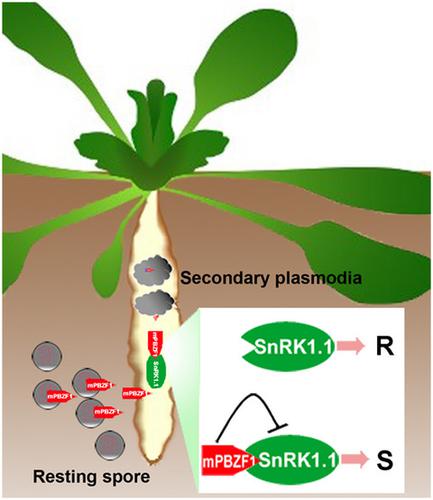当前位置:
X-MOL 学术
›
Mol. Plant Pathol.
›
论文详情
Our official English website, www.x-mol.net, welcomes your
feedback! (Note: you will need to create a separate account there.)
SnRK1.1-mediated resistance of Arabidopsis thaliana to clubroot disease is inhibited by the novel Plasmodiophora brassicae effector PBZF1
Molecular Plant Pathology ( IF 4.8 ) Pub Date : 2021-06-24 , DOI: 10.1111/mpp.13095 Wang Chen 1 , Yan Li 2, 3 , Ruibin Yan 1 , Li Ren 1 , Fan Liu 1 , Lingyi Zeng 1 , Shengnan Sun 1 , Huihui Yang 1 , Kunrong Chen 1 , Li Xu 1 , Lijiang Liu 1 , Xiaoping Fang 1 , Shengyi Liu 1
Molecular Plant Pathology ( IF 4.8 ) Pub Date : 2021-06-24 , DOI: 10.1111/mpp.13095 Wang Chen 1 , Yan Li 2, 3 , Ruibin Yan 1 , Li Ren 1 , Fan Liu 1 , Lingyi Zeng 1 , Shengnan Sun 1 , Huihui Yang 1 , Kunrong Chen 1 , Li Xu 1 , Lijiang Liu 1 , Xiaoping Fang 1 , Shengyi Liu 1
Affiliation

|
Plants have evolved a series of strategies to combat pathogen infection. Plant SnRK1 is probably involved in shifting carbon and energy use from growth-associated processes to survival and defence upon pathogen attack, enhancing the resistance to many plant pathogens. The present study demonstrated that SnRK1.1 enhanced the resistance of Arabidopsis thaliana to clubroot disease caused by the plant-pathogenic protozoan Plasmodiophora brassicae. Through a yeast two-hybrid assay, glutathione S-transferase pull-down assay, and bimolecular fluorescence complementation assay, a P. brassicae RxLR effector, PBZF1, was shown to interact with SnRK1.1. Further expression level analysis of SnRK1.1-regulated genes showed that PBZF1 inhibited the biological function of SnRK1.1 as indicated by the disequilibration of the expression level of SnRK1.1-regulated genes in heterogeneous PBZF1-expressing A. thaliana. Moreover, heterogeneous expression of PBZF1 in A. thaliana promoted plant susceptibility to clubroot disease. In addition, PBZF1 was found to be P. brassicae-specific and conserved. This gene was significantly highly expressed in resting spores. Taken together, our results provide new insights into how the plant-pathogenic protist P. brassicae employs an effector to overcome plant resistance, and they offer new insights into the genetic improvement of plant resistance against clubroot disease.
中文翻译:

SnRK1.1 介导的拟南芥对根肿病的抗性被新的芸苔疟原虫效应物 PBZF1 抑制
植物已经进化出一系列策略来对抗病原体感染。植物 SnRK1 可能参与将碳和能量的使用从与生长相关的过程转变为生存和病原体攻击时的防御,从而增强对许多植物病原体的抵抗力。本研究表明,SnRK1.1 增强了拟南芥对由植物病原原生动物芸苔疟原虫引起的根肿病的抗性。通过酵母双杂交试验、谷胱甘肽 S-转移酶 pull-down 试验和双分子荧光互补试验,得到了一种芸苔RxLR 效应器 PBZF1 与 SnRK1.1 相互作用。对 SnRK1.1 调控基因的进一步表达水平分析表明,PBZF1 抑制 SnRK1.1 的生物学功能,这从异质表达 PBZF1 的拟南芥中SnRK1.1 调控基因的表达水平不平衡表明。此外, PBZF1在拟南芥中的异质表达促进了植物对根肿病的易感性。此外,发现PBZF1是芸苔藓特异性和保守的。该基因在静息孢子中显着高表达。总之,我们的研究结果为植物病原原生生物P. brasicae如何提供了新的见解采用效应器来克服植物抗性,他们为植物抗根肿病的遗传改良提供了新的见解。
更新日期:2021-08-12
中文翻译:

SnRK1.1 介导的拟南芥对根肿病的抗性被新的芸苔疟原虫效应物 PBZF1 抑制
植物已经进化出一系列策略来对抗病原体感染。植物 SnRK1 可能参与将碳和能量的使用从与生长相关的过程转变为生存和病原体攻击时的防御,从而增强对许多植物病原体的抵抗力。本研究表明,SnRK1.1 增强了拟南芥对由植物病原原生动物芸苔疟原虫引起的根肿病的抗性。通过酵母双杂交试验、谷胱甘肽 S-转移酶 pull-down 试验和双分子荧光互补试验,得到了一种芸苔RxLR 效应器 PBZF1 与 SnRK1.1 相互作用。对 SnRK1.1 调控基因的进一步表达水平分析表明,PBZF1 抑制 SnRK1.1 的生物学功能,这从异质表达 PBZF1 的拟南芥中SnRK1.1 调控基因的表达水平不平衡表明。此外, PBZF1在拟南芥中的异质表达促进了植物对根肿病的易感性。此外,发现PBZF1是芸苔藓特异性和保守的。该基因在静息孢子中显着高表达。总之,我们的研究结果为植物病原原生生物P. brasicae如何提供了新的见解采用效应器来克服植物抗性,他们为植物抗根肿病的遗传改良提供了新的见解。











































 京公网安备 11010802027423号
京公网安备 11010802027423号